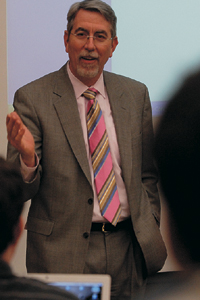University streamlines transcript processing with new cost-effective electronic delivery system
By Julia MorseNews Office
 Thomas Black, University Registrar, conducts a test run of the electronic delivery system for student transcripts. | |
An institution famous for leading the pack in research and technology, Chicago has now become the second university in the nation to provide electronic delivery of transcripts.
After nearly three years of work on the project, University Registrar Thomas Black and University staff have applied proven technology to offer electronic delivery.
“Making the choice to start using electronic transcripts was both natural and crucial for us,” said Black. “I am always looking for ways to make the way we do things easier and better. This is one of those opportunities.”
Students and alumni have had access to electronic delivery of their transcripts since early February in lieu of the more widely used paper transcripts, which are hand-stuffed into envelopes, sealed and mailed.
“It just seemed wrong to me that at Chicago, we are so sophisticated, so technologically advanced in most other ways, but we are still printing out transcripts and sending them out by FedEx,” Black said. “It just didn’t make sense anymore.”
Susan Art, Dean of Students in the College, agreed.
“I am very proud that Chicago’s Office of the Registrar is really on the forefront with this,” Art said. “This will make things much easier for students, and I think it is absolutely great.”
Certifying the authenticity of the electronic transcripts, which are converted into PDF forms and sent via e-mail, is critical to ensuring they cannot be altered and will be recognized as authentic University documents.
Black’s solution is the inclusion of a “digital signature” which will guarantee their legitimacy. The registrar will generate a unique signature for each transcript, based on a fingerprint of the document—ensuring that the contents of the transcript have not been changed and are approved by the University.
“This signature defines each transcript,” Black said. “Not only does it prevent tampering or reproduction, it also promises authenticity to the recipient.”
Using a method that is both affordable and easy for other institutions to adopt, Black hopes other schools that may not have the financial and programming resources to create their own methods, will be able to utilize the University’s system when offering their own electronic transcripts.
Along with Senior Associate University Registrar Andrew Hannah, Black met with members of the College Council to announce the availability of electronic transcripts at Chicago and to provide a demonstration, which walked students through the process of ordering and receiving transcripts electronically.
The students appeared to agree that the new electronic delivery system would be one they would eagerly use, although some students expressed concern over the possibility of negative reactions from recipients.
“Because this is new and unfamiliar to most people, they may receive an electronic transcript and question it,” Black said. “I do not think this will be a big hurdle to overcome, but you may run into it. Like anything new, it takes some time for people to embrace it if they don’t do so right off the bat.”
Black also told the students that during his research and planning, the feedback he received from admissions offices around the country was entirely positive.
“They want to expedite the admissions process,” he said. “This accomplishes that.”
Hannah added, “The transcript is really the last facet of the admissions process that is hard copy—everything else is electronic.”
Following the demonstration, Black asked the College Council if they would use the new system, and all students nodded affirmatively. He then asked the students to try it out on their own to get a hands-on perspective.
“I would like to know what your thoughts are about this,” Black said. “We want you involved in this process, and we want to know your perspective.”
The Office of the University Registrar uses the service of three organizations: the first to provide the digital certificate for the digital signature; the second to apply the signature to the electronic transcripts; and the third to provide ordering and delivery services.
Recipients of the electronic transcripts will receive a statement assuring the safety of the file and instructing how to prove authenticity, if necessary.
“In reality, most people will make a quick visual assessment of the document as to whether or not they can trust it,” Black noted. “Ours looks like Chicago, and if that is questioned, it is proven to be Chicago.”
Once the safety and authenticity of the transcripts was secured, Black said he was able to really digest the many benefits that this change would bring to the University community.
“The electronic transcripts ensure an immediate and secure delivery, it alerts you when the recipient has received it, it’s cost-efficient, it’s better environmentally—and the bottom line is that it’s just easier.”
![[Chronicle]](/images/sidebar_header_oct06.gif)